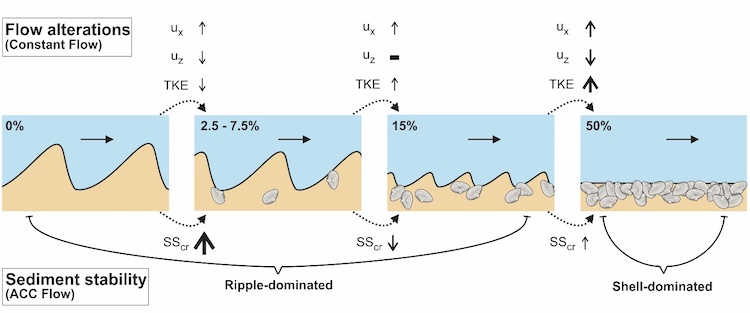C.H. Cheng1,*, J.C. de Smit1, G. S. Fivash1, S. J. M. H. Hulscher2, B. W. Borsje2, K. Soetaert1
1 NIOZ Royal Netherlands Institute for Sea Research, Department of Estuarine and Delta Systems (EDS)
2 Water Engineering and Management, University of Twente, *
Introduction
Shells and shell fragments are biogenic structures that are widespread throughout natural sandy shelf seas. Their presence can affect the bed roughness and erodibility of the seabed, especially given their lower bulk density and significantly different shapes and sizes as compared to the surrounding siliciclastic sediment particles. An important consequence is the effect on the formation and movement of small bedforms such as sand ripples. However, despite the prevalence of shells, their direct influence on the geomorphological dynamics of sandy sediments has not been well-studied.
Methods and results
We experimentally measured ripple formation and migration using a mixture of natural sand and increasing volumes of shell material under unidirectional flow in a racetrack flume. Two separate experiments were conducted to (1) measure the equilibrium ripple dimensions and migration rates over a constant flow velocity, and (2) determine the incipient sediment motion over gradually accelerating flow.
Our experiments reveal the impacts of shells on ripple development in sandy sediment, thus providing information that was previously lacking. Shells expedite the onset of sediment transport while simultaneously reducing ripple dimensions and slowing down their migration rates. Moreover, increasing shell content enhances near-bed flow velocity due to the reduction of bed friction that is partly caused by a decrease in average ripple size and occurrence. This, in essence, limits the rate and magnitude of bedload transport. Given the large influence of shell content on sediment dynamics on the one hand, and the high shell concentrations found naturally in the sediments of shallow seas on the other hand, a significant control from shells on the morphodynamics of sandy marine habitats is expected.

Figure: Conceptual figure showing how shells affect the hydrodynamic conditions, under flat and rippled-bed conditions. In the absence of ripples, shells effectively create roughness for the otherwise-flat bed. As the concentrations of shells increase and exceed a certain threshold, a density-dependent effect on near-bed flow attenuation can be observed, where the increasingly dense and immobile shell clusters exhibit a dampening behavior. TKE = turbulent kinetic energy; ux = depth-averaged horizontal velocity; uz = depth-averaged vertical velocity; SScr = critical shear stress.
I. Surname1*, F.N. Another-Surname2 , Y. Next-Surname2
1 University Name, Country; 2 Organization Name, Country
* Corresponding author: mail.name@organization.org


